The previous posts First one / Second one
The day did not start well: first we were woken at 4 in the morning by a rather enthusiastic waiter, who, the previous night took his tea order right but not the room to which the order had to be delivered. Instead of realising that it was improper to wake people up so early, he was insisting that this was the room to which it had to be delivered. Half believing me, he yelled to his friend who must have been at the end of the corridor to double check the room. His friend yelled back that he got the room wrong. “Sorry sir-ji”, our ‘polite’ youth said and went to loudly knock the room few doors further.
This woke me up completely and I realised I had a frog in my throat. Not a good sign since that means a cold is around the corner. I have a strange warning mechanism for a cold: first I wake up with a sore throat that too on ONE side (I am not joking), then as the pain disappears the nostril on the erstwhile sore part starts to go on an overdrive and then the next nostril suddenly remember it needs to act in tandem with its sibling . Strange isn’t it? Well each of us are as strange as our own ailments.
After tossing around for a while on the bed and when it was light enough, I went to inform the manager that he can arrange to send hot water to my room, he was not in his seat and the kitchen folks casually mentioned, while warming themselves at the cook-stove, that the boiler broke down and we have to make do with cold water, if we intend having a bath at all. The water was freezing to say the least. I then remembered my bathing scheme in Pune/Hyderabad in winters (we did not have a geyser): pour water on feet first… then on knees… shiver… then stare hard at the water in the bucket expecting to warm it a la superman and in a swift movement douse the entire body supported by appropriate squirms and screams. I must add that after the first few mug-fulls the batch actually starts to be enjoyable. I tried to emulate the same routine here but it was more pride than cleanliness that prompted me to perform the drill.
Having accomplished this feat, I went over to adjoining room where my friends were still lolling in bed, told them that there is no hot water and that I went through my ablutions with cold water, as befitting anyone wanting to scale the might Himalayas. One of them was not amused. He had a fight with manager who promptly got hot water organised for him and others. Wife gave me icicle laden stares for she succumbed to my motivating talk a little earlier. Anyway, casually casting those stares aside, and with a head stuck out like a proud rooster, I went to the restaurant and polished few hot alu-parathas not-withstanding the sore food passage. With mango-pickle burps and a satisfied stomach, I limbered up a bit by walking around the campus taking a snap here and there as I waited for the rest to take a short ride to Gaurikund where the path to Kedar starts.
The ride to Gaurikund with some spectacular views of the sun-kissed mountains, in ideal conditions should have taken ten minutes. In reality it took close to an hour. The first seven minutes were close to the ideal state but the next three minutes weren’t as we ran into a long line of vehicles, all at a standstill, waiting to get to Gaurikund. Two of us jumped out to do some restless and pointless activities. Before we could get a porter to haul our luggage to the main gateway, the vehicles started to inch ahead. The brown kucha road was little wider than two vehicles and there were whole bunch of people (porters, drivers, cleaners, bhel-wala, etc.) creatively taking up all kinds of spaces – tree stumps, jutting rocks, rubbish mounds. A slow and careful ride (not to knock other vehicles into the steep valley or spread smiling Nepalese nicely along the mountain wall) took us to a little square half the size a foot ball field. To say it was chaotic was to say the least. There were about a 100 vehicles, half of them discharging their load of giggling enthusiastic families all eager to jog up the 14 km path to Kedar; other half picking up weary families wondering why on earth were they so enthusiastic and eager to get some brownie points, that too for a supposedly next life. In between these vehicles were families waiting impatiently for their vehicles to turn up so that they can put behind as much distance as possible from this place. In total it was chaos of a new order. The fact that all this happens without much ado is a miracle in itself. Actually there were also some folks with that ‘been there and done it” kind of look but they were the fat folks who did the trek on other beings.
We gave the customary dip in the Kund before the trek to Kedar a miss, and went on to pass through the welcoming arch and throbbing crowds onto a stone paved path with varying commercial activities on its sides. Lugging our loads to the GMVN (the state run guest house), where our driver said that the staff will help us get a good porter. They were trying to palm some of their cronies who were asking more than normal rates, which obviously included some generous kickbacks here and there. I enthusiastically volunteered to keep an eye on the luggage so that the others can span out to find a porter willing to transport our luggage at a price that was comfortable for us. I love my friends when they fall for such displays of unbridled enthusiasm.
Each of us kept a small backpack with a bottle of water. I volunteered to carry two extra bottles of water. Folks, you may smile at my brag about these bottles, but let me tell you hoisting two extra kg all along the path that winds 14 km in length and two km up into the sky is no mean feat. This is the kind of trek, half way through lazy bums like me would have realised their folly of not cutting those finger-nails and thereby shedding few grams.
Anyway, the first km was the hardest part thanks to the crowds. In addition to the normal demography found at the Gaurikund square, the path also houses ponies, dholies (palanquins) with their fat inhabitants and lean carriers and porters carrying very young or very old in baskets tied to their foreheads and waist. And doing their wee bit to give a quaint farm smell were the pony droppings. Amidst all these, sights and sounds of gushing, milky Mandakini on our left was the only positive
Thursday, December 28, 2006
Wednesday, December 27, 2006
Chettinad trip (made a year ago)
There are two ways to experience Chettinad heritage. For the sake of comparison let me say one is easy and the other is difficult. Naturally, the experience each one offers is slightly different from the other since the efforts involved are different. The easy way is to experience it in Chennai and the difficult way is to experience it in Chettinad itself. There are places in Chennai where one can eat Chettinad food, visit a traditional Chettinad house and then purchase Chettinad crafts. Perhaps, as it was for me, starting out in Chennai may be an easy choice for many.
There are many places to eat authentic Chettinad food (I am a sucker for food, so I believe what the blurbs on name boards and menu cards say). Some of the more prominent ones are Anjapaar, Ponuswamy and Kaaraikudi. These hotels have a number of branches and hence are well spread out in the city. So if you want to eat a Chettinad meal, It is quite likely that the area in which you are will have a branch of these restaurants nearby. Then to visit a Chettinad house, you could visit DakshinaChitra, an open air museum of South Indian Culture started by an American lady Dr. Deborah Thiagarajan. This centre is now the home many authentic houses from Kerala, TN, AP and Karnataka. They have been dismantled, numbered carefully and reconstructed to the original form. Along with these architectural experiences, one can browse around in the craft shop that showcases handicrafts from these states. On weekends and during festival seasons, one can see how some of these crafts are produced. To pick up exclusive crafts from Chettinad, one can head towards M.Rm.Rm Foundation set up and run by Mrs. Visalakshi Ramaswamy. She has revived many crafts forms and has received International recognition. One can purchase Kottans (lovely woven baskets for which UNESCO has given their seal of recognition for this crafts), Attangudi Tiles (floor tiles made in vivid colours and designs that don the traditional houses) and handwoven sarees both in cotton and in silk with typical Chettinad designs. One can set aside a day to experience at a leisurely pace or can run through these sights and tastes in half a day.
There are many ways in which one can experience Chettinad heritage in Chettinad region and my Chettinad experiences have been in bits and pieces over the years. The source can be traced to Chennai years ago. I was in this city for a cousin’s wedding and I a missed opportunity to eat at a ‘Chettinad’ restaurant. Considering that I like food very much it was quite natural that I felt disappointed and wanted to make amendments the next time I was in the city. I had to wait for about 12 years for that. Due to some chance happening I moved to live in Chennai and after we settled I wanted to fulfil that desire of eating Chettinad food. Naturally as a newbie to the city, I asked acquaintances about which restaurant to go to. In addition to some names of restaurants, I was told that this cuisine is more renowned for its non veg preparations and that I, a vegetarian, will have limited choice. Nonetheless, when an opportunity presented itself, I took a Dutch friend of mine, who appreciates many good things about India including the spicy food, to Kaaraikudi, a restaurant chain that specialises in Chettinad cuisine. During the days that preceded this dinner, when my friend and I ate out, kozhambu (tamarind based chutney) was something both of us liked very much. So we were quite happy to order poondu kozhambu (with large pieces of garlic in it) and kathirikai kozhambu, (with eggplant) along with Chettinad Biryani and Malabar Parata. The waiter recommended crispy valiapoo vadai (banana flower vada) as starters. Frankly, there was not much of a choice for a veggie but then when the food did arrive, we did not speak a single word during the entire meal; it was just appreciative nods all the way. Although I ate this meal over a year ago the fact that I can still recall the menu seem to indicate that I have an elephantine memory but it is not so. Considering that I have gone back to this restaurant few times and considering that there is little to choose for a vegetarian, it is not difficult to jog the memory (and the taste buds too)
Taking into account that we were to take a group of Dutch tourists on a food tour of south India, after the first meal itself, we decided to explore possibilities of including Chettinad in the tour. My friend left for his home that night and it was my responsibility to investigate. After couple of months of casual research, I had some information and few cancelled train tickets. With time not entirely on our side, my friend, who arrived just before the trip started, managed to organise a day long trip for himself from Madurai. Strangely, I was in The Netherlands then. His feedback was that the roads were bad but it would be extremely interesting for the group to spend a day visiting some of the temples and then to have a meal at Bangla, a restored mansion in Karaikudi that now operated as a heritage hotel. The plan was to leave early in the morning from Madurai, go to Pilliarpatti, where the morning aarti is carried out at 9 AM. Then go to Kundrakudi a Murugan temple on a large rock. Subsequently we planned to go to Kannadukattan, the main Nathukottu Chetiar’s village and finally to Bangla for lunch.
Although we started early, we could not get to Pilliarpatti by 9AM, we were little late. We jumped off the bus and rushed straight into the temple, the aarti was just getting over. We saw the last part of the aarti and even that was quite impressive. The plate with burning camphor circling around an impressive 6 ft Karpaga Vinayaka idol, accompanied with live music and temple bells was quite celestial. Since the group could not enter temples in Kerala or the Meenakshi temple in Madurai, this was the first entry into a Temple for some of them, they I am sure would have been more impressed then I was.
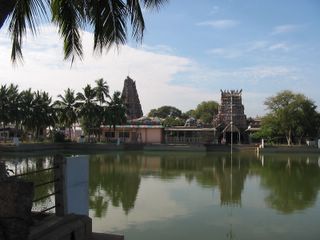
Pillayarpatti temple
Although, the priests told us we could take snaps as long as the deity is not in the picture frame but the guards and the security personnel did not allow us to do so. Since I could not speak Tamil, it was not possible to explain that the priests gave their consent. The next best thing to do was to look for the priests but they were nowhere to be seen. We wandered out and then walked around the temple for a little while. I took some surreptitious snaps as I walked out but none of came out right. Meanwhile, the group got even more disbursed - some members were busy buying trinkets from the shops, couple of others were busy taking snaps of the cows, few were walking around the temple zone and some headed back to the bus. It took a little while to gather them and be on the way to Kundrakudi.
Kundrakudi is famous for a Murgan temple situated on a large rock. At the base of the rock is a small temple with lovely paintings all around, including on the roof. To get to the main temple one has to climb a flight of steps carved into the rock. Even though it was the middle of the day, the climb was not difficult, with gentle breeze and sylvan sights to assist you.
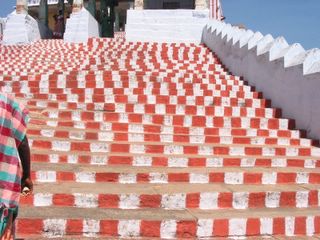
Temple steps
On the right side of the rock was the village with its ‘country tile’ roofs and the left side was natural landscape that extended for quite a distance. Amidst the village one could see the large temple chariot towering over the roofs. It was festooned with mango leaves from a recent temple festival. Once in the temple, I sat in a corner to watch the people. The group wandered around smiling and saying hello to the people. Little kids encouraged by the family came up shyly to shake hands with them. Some of the lesser shy ones asked the group for their names, as the rest of their family stayed in the background, beaming with pride. I can tell that it takes a lot of guts to go up to a stranger and ask for their names, that too strangers from distant lands. I don’t think I can still do that, so I thought the families have all the reason to beam and be proud of their kids.
After few more km of bad roads, we finally arrived at Kannadukattu. A winding path from the edge of the village lead up to the main attraction: the raja’s palace. As we drove into the village the sights the villages had to offer were quite surreal: considering that the village was middle of no-where it had some of the most massive mansions I have ever seen. The group must be even more dazed to see them. The palace where the wealthiest of the Chettiars lived was newly painted. I guess, it was more because of the wealth and the land this family controlled, the head of it was called the Raja and his residence has come to be known as ‘the palace’. Later on I came to know that this place gets painted every January. Since we visited in mid-February, the paints were still bright. While the group went in, I walked around the village to take a few photos. Two more bus loads of overseas tourists came in.
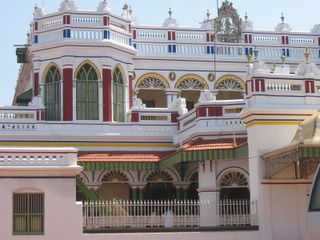
The raja's palace
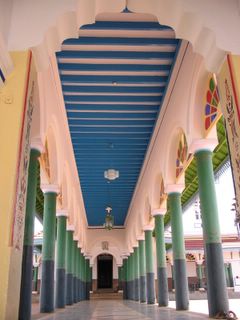
The passage from the entrance to the 'palace'
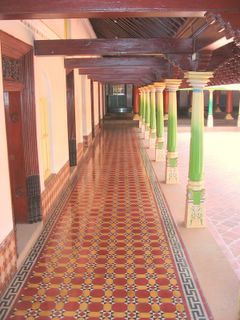
Athangudi tiled passage
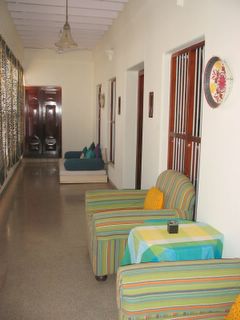
Verandah in Bangla
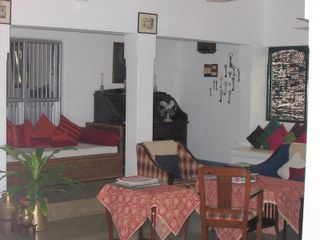
Waiting area in the Bangla
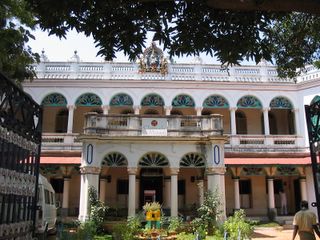
One of the heritage hotels
I guess Chettinad is finally getting onto the tourist map of the country but unfortunately it is the overseas visitors that seem to throng to this place. The only other people who throng this place are antique hunters who carry the dismembered parts of a Chettiyar house to where ever they can sell at exorbitant prices. Next time I am in the Chettinad region, I will make some time to pick up some good deals so that a part of Chettinad is always close by.
There are many places to eat authentic Chettinad food (I am a sucker for food, so I believe what the blurbs on name boards and menu cards say). Some of the more prominent ones are Anjapaar, Ponuswamy and Kaaraikudi. These hotels have a number of branches and hence are well spread out in the city. So if you want to eat a Chettinad meal, It is quite likely that the area in which you are will have a branch of these restaurants nearby. Then to visit a Chettinad house, you could visit DakshinaChitra, an open air museum of South Indian Culture started by an American lady Dr. Deborah Thiagarajan. This centre is now the home many authentic houses from Kerala, TN, AP and Karnataka. They have been dismantled, numbered carefully and reconstructed to the original form. Along with these architectural experiences, one can browse around in the craft shop that showcases handicrafts from these states. On weekends and during festival seasons, one can see how some of these crafts are produced. To pick up exclusive crafts from Chettinad, one can head towards M.Rm.Rm Foundation set up and run by Mrs. Visalakshi Ramaswamy. She has revived many crafts forms and has received International recognition. One can purchase Kottans (lovely woven baskets for which UNESCO has given their seal of recognition for this crafts), Attangudi Tiles (floor tiles made in vivid colours and designs that don the traditional houses) and handwoven sarees both in cotton and in silk with typical Chettinad designs. One can set aside a day to experience at a leisurely pace or can run through these sights and tastes in half a day.
There are many ways in which one can experience Chettinad heritage in Chettinad region and my Chettinad experiences have been in bits and pieces over the years. The source can be traced to Chennai years ago. I was in this city for a cousin’s wedding and I a missed opportunity to eat at a ‘Chettinad’ restaurant. Considering that I like food very much it was quite natural that I felt disappointed and wanted to make amendments the next time I was in the city. I had to wait for about 12 years for that. Due to some chance happening I moved to live in Chennai and after we settled I wanted to fulfil that desire of eating Chettinad food. Naturally as a newbie to the city, I asked acquaintances about which restaurant to go to. In addition to some names of restaurants, I was told that this cuisine is more renowned for its non veg preparations and that I, a vegetarian, will have limited choice. Nonetheless, when an opportunity presented itself, I took a Dutch friend of mine, who appreciates many good things about India including the spicy food, to Kaaraikudi, a restaurant chain that specialises in Chettinad cuisine. During the days that preceded this dinner, when my friend and I ate out, kozhambu (tamarind based chutney) was something both of us liked very much. So we were quite happy to order poondu kozhambu (with large pieces of garlic in it) and kathirikai kozhambu, (with eggplant) along with Chettinad Biryani and Malabar Parata. The waiter recommended crispy valiapoo vadai (banana flower vada) as starters. Frankly, there was not much of a choice for a veggie but then when the food did arrive, we did not speak a single word during the entire meal; it was just appreciative nods all the way. Although I ate this meal over a year ago the fact that I can still recall the menu seem to indicate that I have an elephantine memory but it is not so. Considering that I have gone back to this restaurant few times and considering that there is little to choose for a vegetarian, it is not difficult to jog the memory (and the taste buds too)
Taking into account that we were to take a group of Dutch tourists on a food tour of south India, after the first meal itself, we decided to explore possibilities of including Chettinad in the tour. My friend left for his home that night and it was my responsibility to investigate. After couple of months of casual research, I had some information and few cancelled train tickets. With time not entirely on our side, my friend, who arrived just before the trip started, managed to organise a day long trip for himself from Madurai. Strangely, I was in The Netherlands then. His feedback was that the roads were bad but it would be extremely interesting for the group to spend a day visiting some of the temples and then to have a meal at Bangla, a restored mansion in Karaikudi that now operated as a heritage hotel. The plan was to leave early in the morning from Madurai, go to Pilliarpatti, where the morning aarti is carried out at 9 AM. Then go to Kundrakudi a Murugan temple on a large rock. Subsequently we planned to go to Kannadukattan, the main Nathukottu Chetiar’s village and finally to Bangla for lunch.
Although we started early, we could not get to Pilliarpatti by 9AM, we were little late. We jumped off the bus and rushed straight into the temple, the aarti was just getting over. We saw the last part of the aarti and even that was quite impressive. The plate with burning camphor circling around an impressive 6 ft Karpaga Vinayaka idol, accompanied with live music and temple bells was quite celestial. Since the group could not enter temples in Kerala or the Meenakshi temple in Madurai, this was the first entry into a Temple for some of them, they I am sure would have been more impressed then I was.

Pillayarpatti temple
Although, the priests told us we could take snaps as long as the deity is not in the picture frame but the guards and the security personnel did not allow us to do so. Since I could not speak Tamil, it was not possible to explain that the priests gave their consent. The next best thing to do was to look for the priests but they were nowhere to be seen. We wandered out and then walked around the temple for a little while. I took some surreptitious snaps as I walked out but none of came out right. Meanwhile, the group got even more disbursed - some members were busy buying trinkets from the shops, couple of others were busy taking snaps of the cows, few were walking around the temple zone and some headed back to the bus. It took a little while to gather them and be on the way to Kundrakudi.
Kundrakudi is famous for a Murgan temple situated on a large rock. At the base of the rock is a small temple with lovely paintings all around, including on the roof. To get to the main temple one has to climb a flight of steps carved into the rock. Even though it was the middle of the day, the climb was not difficult, with gentle breeze and sylvan sights to assist you.

Temple steps
On the right side of the rock was the village with its ‘country tile’ roofs and the left side was natural landscape that extended for quite a distance. Amidst the village one could see the large temple chariot towering over the roofs. It was festooned with mango leaves from a recent temple festival. Once in the temple, I sat in a corner to watch the people. The group wandered around smiling and saying hello to the people. Little kids encouraged by the family came up shyly to shake hands with them. Some of the lesser shy ones asked the group for their names, as the rest of their family stayed in the background, beaming with pride. I can tell that it takes a lot of guts to go up to a stranger and ask for their names, that too strangers from distant lands. I don’t think I can still do that, so I thought the families have all the reason to beam and be proud of their kids.
After few more km of bad roads, we finally arrived at Kannadukattu. A winding path from the edge of the village lead up to the main attraction: the raja’s palace. As we drove into the village the sights the villages had to offer were quite surreal: considering that the village was middle of no-where it had some of the most massive mansions I have ever seen. The group must be even more dazed to see them. The palace where the wealthiest of the Chettiars lived was newly painted. I guess, it was more because of the wealth and the land this family controlled, the head of it was called the Raja and his residence has come to be known as ‘the palace’. Later on I came to know that this place gets painted every January. Since we visited in mid-February, the paints were still bright. While the group went in, I walked around the village to take a few photos. Two more bus loads of overseas tourists came in.

The raja's palace

The passage from the entrance to the 'palace'

Athangudi tiled passage

Verandah in Bangla

Waiting area in the Bangla

One of the heritage hotels
I guess Chettinad is finally getting onto the tourist map of the country but unfortunately it is the overseas visitors that seem to throng to this place. The only other people who throng this place are antique hunters who carry the dismembered parts of a Chettiyar house to where ever they can sell at exorbitant prices. Next time I am in the Chettinad region, I will make some time to pick up some good deals so that a part of Chettinad is always close by.
Monday, July 10, 2006
up the hills...
The next morning we were woken by early by the GMVN staff to let us know that our Sumo has arrived. We quickly got into the act of leaving by making arrangements for breakfast (food has to be ordered at least half an hour earlier) and then packing. While K and I munched on the alu parathas, the rest decided to have a 'fruit breakfast'. So our first stop on the trip was the fruit market.
At the fruit market, three of us headed in different directions to pick up banana, litchis and other exotic fruit (which were quite expensive). Here I noticed that most of the mangoes were banginalpalli and speaking as a Vizag-ite, these were from my own backyard: Vizianagaram (Could see it on the boxes). Mango wars have been going on for years between my wife and me. This time she had a lot of support from my friends who are from Bombay also. Like a true blue Andhra-ite, I think Banginalpalli is a great variety. I would never term Alphanso the king of all mangoes. So, this was a great way to start the trip. I pulped my opponents into submission that while the western Indians think Alphanso is great, the rest of the country swears by the likes of Banginalpalli (I threw in some fake statistics for good measure). Well with this tirade, I kissed goodbye to the few A mangoes my friend lugged all the way.
Getting back to the story, we soon went past the two famous suspension bridges: ram and lakshman jhula and headed into the mountains. The day was cloudy and the chances of rain up in the mountains were high said the driver. We stopped to wrap our luggage in tarpaulin. He wrapped and we looked around. My friends went to Gangotri few years ago, and the start was similar: cloudy and wet but once the sun came out the next day, they said, it stayed dry throughout.
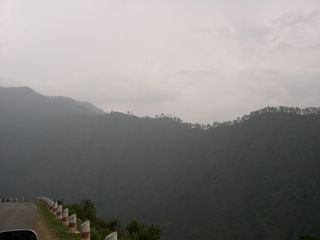
cloudy skies...
Soon we started the assent into the mountains with the river Ganga next to us, growing smaller as we climbed higher. As we moved, we could see how it wound around mountains, flowed over stony beds, frothed in exuberance and playfully meandered as it ran down into the plains. Along some of the banks was tented accommodation for the more adventurous folks and for those who wanted to raft. As we went higher, clouds shielded the rest of the ranges so all we saw was a mountain or two, which were close to us. This was not one continuous assent, we went up a hill, and then went down only to climb up another. At no point of time, we were away from the river or its tributaries.

Meandering Mandakini
In the excitement of the sights around and more due to the dizzily changing landscape, I felt motion sickness for the first time. Since lemon is said to have some curative properties to this ailment, I sucked on one with my eyes shut. It helped a bit but the queasiness in the stomach stayed. It stayed until we reached the surroundings of Rudrayprayag where we had our lunch. Strangely, I did not feel it afterwards.
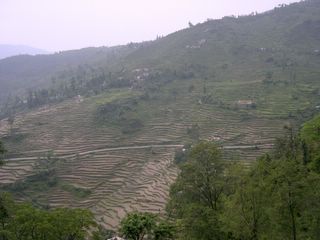
Tried to get the patterned landscape but failed.
The only stop we made before lunch was Deoprayag where, Alaknanda (from Badrinath) meets Baghirati (from Gangotri) meet to become Ganga. My friend wanted to go down to the sangam; we thought it would be a good break. To get there, we had to walk on one of the many suspension bridges that span these rivers to get onto the other side. Then walk along the narrow sloping road that leads to the ghats. However before doing so we had to get past the pandas. They insisted that we perform some puja or other. The only thing that worked was to ignore them completely. I wonder why they cannot not be polite, ask once and let go. It is not that everyone who comes here performs puja. On our way back I purchased some more lemons as a precautionary measure. Last thing I wanted was to seem like a sissy by throwing up.
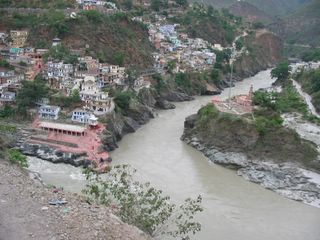
Alaknanda meeting Bhagirathi to become Ganga @ Deoprayad
We were to stop for the night at Rampur, a few km from Gaurikund. The trek to Kedar starts from Gaurikund. We reached this place amidst drizzles while clouds covered all the ranges and the wonderful sights these mountains could have been providing us. Normally, we could have noticed one or two snow peaks by now said the driver to add to our misery.
The GMVN was located on an edge of a small hillock. A small rivulet flowed past the foot of this hillock and the gushing sounds of it filled the entire guest house. One of the two rooms we had, had a balcony that looked down upon this scene. On the other side of the rivulet, rose a fairly large hill covered with thick greenery.

View from the balcony
After a quick cup of tea, we walked along the road until the next village, logically named Sitapur. While we were walking, we were given a sneak preview of the ranges hidden by the clouds. A near range comes out first. Having seen this, we started to look for formations behind the clouds to spot ranges. Our conversation was like this, "hey, see that! that looks like a range, wow"... "what wow? look a little above that point, doesn't that looks like a range that is even higher?".. "yeah, I think so". By the time we walked back, we could distinctly identify some of the ranges we 'wowed'.
The next morning when I woke up the temp was crisp and invigorating. The whole place was filled with the sounds of many song birds while the gushing sound of the rivulet provided the background. I get up to look out of the window and I see the sun striking one of the ranges. It was a lovely feeling. On the flip side, I had a bad sore throat.
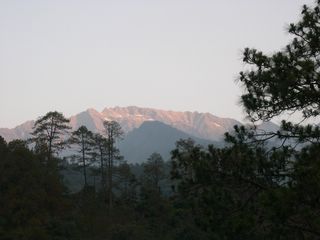
Early morning sun

Close-up...
It was going to be a big day: we will be climbing 1800 mt over a 14 km trek. In all excitement, we pack and headed off to Gaurikund. And that will be the next part. This was the sight that greeted us as we went out...
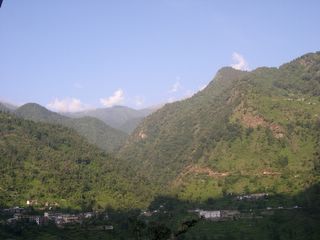
Himalayas @ 1800 mts
At the fruit market, three of us headed in different directions to pick up banana, litchis and other exotic fruit (which were quite expensive). Here I noticed that most of the mangoes were banginalpalli and speaking as a Vizag-ite, these were from my own backyard: Vizianagaram (Could see it on the boxes). Mango wars have been going on for years between my wife and me. This time she had a lot of support from my friends who are from Bombay also. Like a true blue Andhra-ite, I think Banginalpalli is a great variety. I would never term Alphanso the king of all mangoes. So, this was a great way to start the trip. I pulped my opponents into submission that while the western Indians think Alphanso is great, the rest of the country swears by the likes of Banginalpalli (I threw in some fake statistics for good measure). Well with this tirade, I kissed goodbye to the few A mangoes my friend lugged all the way.
Getting back to the story, we soon went past the two famous suspension bridges: ram and lakshman jhula and headed into the mountains. The day was cloudy and the chances of rain up in the mountains were high said the driver. We stopped to wrap our luggage in tarpaulin. He wrapped and we looked around. My friends went to Gangotri few years ago, and the start was similar: cloudy and wet but once the sun came out the next day, they said, it stayed dry throughout.

cloudy skies...
Soon we started the assent into the mountains with the river Ganga next to us, growing smaller as we climbed higher. As we moved, we could see how it wound around mountains, flowed over stony beds, frothed in exuberance and playfully meandered as it ran down into the plains. Along some of the banks was tented accommodation for the more adventurous folks and for those who wanted to raft. As we went higher, clouds shielded the rest of the ranges so all we saw was a mountain or two, which were close to us. This was not one continuous assent, we went up a hill, and then went down only to climb up another. At no point of time, we were away from the river or its tributaries.

Meandering Mandakini
In the excitement of the sights around and more due to the dizzily changing landscape, I felt motion sickness for the first time. Since lemon is said to have some curative properties to this ailment, I sucked on one with my eyes shut. It helped a bit but the queasiness in the stomach stayed. It stayed until we reached the surroundings of Rudrayprayag where we had our lunch. Strangely, I did not feel it afterwards.

Tried to get the patterned landscape but failed.
The only stop we made before lunch was Deoprayag where, Alaknanda (from Badrinath) meets Baghirati (from Gangotri) meet to become Ganga. My friend wanted to go down to the sangam; we thought it would be a good break. To get there, we had to walk on one of the many suspension bridges that span these rivers to get onto the other side. Then walk along the narrow sloping road that leads to the ghats. However before doing so we had to get past the pandas. They insisted that we perform some puja or other. The only thing that worked was to ignore them completely. I wonder why they cannot not be polite, ask once and let go. It is not that everyone who comes here performs puja. On our way back I purchased some more lemons as a precautionary measure. Last thing I wanted was to seem like a sissy by throwing up.

Alaknanda meeting Bhagirathi to become Ganga @ Deoprayad
We were to stop for the night at Rampur, a few km from Gaurikund. The trek to Kedar starts from Gaurikund. We reached this place amidst drizzles while clouds covered all the ranges and the wonderful sights these mountains could have been providing us. Normally, we could have noticed one or two snow peaks by now said the driver to add to our misery.
The GMVN was located on an edge of a small hillock. A small rivulet flowed past the foot of this hillock and the gushing sounds of it filled the entire guest house. One of the two rooms we had, had a balcony that looked down upon this scene. On the other side of the rivulet, rose a fairly large hill covered with thick greenery.

View from the balcony
After a quick cup of tea, we walked along the road until the next village, logically named Sitapur. While we were walking, we were given a sneak preview of the ranges hidden by the clouds. A near range comes out first. Having seen this, we started to look for formations behind the clouds to spot ranges. Our conversation was like this, "hey, see that! that looks like a range, wow"... "what wow? look a little above that point, doesn't that looks like a range that is even higher?".. "yeah, I think so". By the time we walked back, we could distinctly identify some of the ranges we 'wowed'.
The next morning when I woke up the temp was crisp and invigorating. The whole place was filled with the sounds of many song birds while the gushing sound of the rivulet provided the background. I get up to look out of the window and I see the sun striking one of the ranges. It was a lovely feeling. On the flip side, I had a bad sore throat.

Early morning sun

Close-up...
It was going to be a big day: we will be climbing 1800 mt over a 14 km trek. In all excitement, we pack and headed off to Gaurikund. And that will be the next part. This was the sight that greeted us as we went out...

Himalayas @ 1800 mts
Wednesday, June 21, 2006
Himalayan (mis)adventure
When my friend called early January to ask us if we would like to join them for a holiday in the himalayas, both of us said yes at once. I was sure I would be able to make it but we were not sure if K (my wife) could join us for the entire trip. Although it was at the back of our mind, we did not think about it until we have a mail from our friend giving us the dates and the possible itinerary that the trip started becoming real. Booking the trains and the places was a flurry of activities, where I had a very small role to play. Even though the trip was months away, some of the train tickets were waitlisted. Talk about the country on the move during the holiday season.
Something that I should have done first was to ask my friend what kind of route we would be taking. Later on when I did eventually ask her, we were to be going through the pilgrims route of Kedar, Badri and Hemkund. This certainly did deflate me. I am not too religious and the last thing I would like to do on a holiday is to jostle around for elbow space with faith-filled-pilgrims. I have nothing against them, just that I, a faithless fellow, would like to avoid taking up space that can be filled by a devoutee. I have stopped going to the Tirupati temple for that very reason. Once in a while, I go visit my friend who lives very close to Tirupati, visit some nearby temples (usually Kalahasti) and then head back. I like to go to temples where I can see the architecture, look at the sculptures, soak in the ambience, watch devotees mill around. Basically not too popular temples. So I told my friend that this route was not too exciting to me. She explained that although there will be many tourists, the sights and sounds are out of the world and that I should experience them atleast once. Yeah?, I said sarcastically, but why on my first trip to the Himalayas. She said, "come on, dont be such a spoil sport". Although that conversation ended my sulking trip, I nevertheless was not over excited about the 'sights and sounds'
The day finally arrived when we had to get to the station and be on the move. The trip to Delhi was OK. Would have loved to take the Rajadhani but thought TN Express would be more comfortable due to the timings. Well I dont know how Rajadhani would have been but TN was certainly not the best of the trips. The train doesnt stop anywhere, the food inside the train was lousy and we were not carrying food like the most of the other passengers. The only two high points of food during the trip were, a lovely mango juice at Nagpur and a great puri-subji at Itarsi. Ater reaching Delhi and after managing to get a dorm for four at the Rail Yatri Niwas, we waited for my friends from Mumbai to reach. After they arrived, after we chatted, after we checked out what munchies we got for the trip, after we finished our baths, we headed out to check out the Delhi metro and get some food at CP.
The metro was great. It was swanky, neat and quite well worked out. We were very impressed. But then because we could not read the signs properly and because the local could not direct us to the right exit, we had to walk a bit before we got to where we wanted to go on CP: a food joint. It was too expensive. The next one was too dirty and also served meat. Since one of us was an animal rights activist, we did not want to hurt his feelings too much by hogging at these veg/non veg joints, although all of us were veggies. Finally ate a meal at the Nirula bar. We had a veg buffet and ran back to the station to get our train.
The AC in the train to Haridwar was too cold and the fan was right above my head. When I wanted to switch off the fan, the lady beind me complained that she was not getting enough air. Ended up having a heavy head. I wondered later, why did I not ask her to swap seats. It was while on train, I realised that we had our room in Rishikesh and that the train does not stop there. So, soon after we got off at 8.00 PM, we hired a strange looking autorick, which that northern part of the country is full off, to drop us at our hotel in Rishikesh. While A and R were bargaining, K went off to buy some litchis. I sat in the front with the driver while the rest squeezed at the back. We went past the Har-ki-pauri, past some temples and some forest before reaching the hotel of GMVN (garhwal mandal vikas nigam), the tourist wing of uttaranchal govt.
While getting here, my first sight of Ganga, was when we went onto a bridge. So, here was a majestic river, in full flow with ghats on my left and a lone lamp floated by, twirling in an eddy. Dont think I will forget that sight for long time. Then later I thought, there was Ganga, which for many people who come here, is a body of holy water that orginates from the lock of the god himself, that in the past has liberated the souls of many of Rama's ancestor, and who will wash away all their sins and help them relieve the burden of karma. But for me, a faith-less fool, what did I want to remember it by? A visual of a lamp floating by. Well I slept that night thinking there are many that make this world and I am one of them.
Anyway, early in the morning we were woken up by one of the GMVN staff , saying that our sumo has arrived. After a breakfast of tea and alu-parathas (which, incidentally we got sick of by the time the trip ended) and a small altercation with the driver, we were off to the hills.
So why was this a mis-adventure? keep watching this space for more... Here is a picture of the hills.
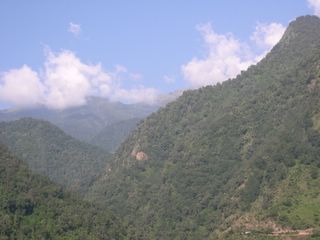
Looking down into the vales
Something that I should have done first was to ask my friend what kind of route we would be taking. Later on when I did eventually ask her, we were to be going through the pilgrims route of Kedar, Badri and Hemkund. This certainly did deflate me. I am not too religious and the last thing I would like to do on a holiday is to jostle around for elbow space with faith-filled-pilgrims. I have nothing against them, just that I, a faithless fellow, would like to avoid taking up space that can be filled by a devoutee. I have stopped going to the Tirupati temple for that very reason. Once in a while, I go visit my friend who lives very close to Tirupati, visit some nearby temples (usually Kalahasti) and then head back. I like to go to temples where I can see the architecture, look at the sculptures, soak in the ambience, watch devotees mill around. Basically not too popular temples. So I told my friend that this route was not too exciting to me. She explained that although there will be many tourists, the sights and sounds are out of the world and that I should experience them atleast once. Yeah?, I said sarcastically, but why on my first trip to the Himalayas. She said, "come on, dont be such a spoil sport". Although that conversation ended my sulking trip, I nevertheless was not over excited about the 'sights and sounds'
The day finally arrived when we had to get to the station and be on the move. The trip to Delhi was OK. Would have loved to take the Rajadhani but thought TN Express would be more comfortable due to the timings. Well I dont know how Rajadhani would have been but TN was certainly not the best of the trips. The train doesnt stop anywhere, the food inside the train was lousy and we were not carrying food like the most of the other passengers. The only two high points of food during the trip were, a lovely mango juice at Nagpur and a great puri-subji at Itarsi. Ater reaching Delhi and after managing to get a dorm for four at the Rail Yatri Niwas, we waited for my friends from Mumbai to reach. After they arrived, after we chatted, after we checked out what munchies we got for the trip, after we finished our baths, we headed out to check out the Delhi metro and get some food at CP.
The metro was great. It was swanky, neat and quite well worked out. We were very impressed. But then because we could not read the signs properly and because the local could not direct us to the right exit, we had to walk a bit before we got to where we wanted to go on CP: a food joint. It was too expensive. The next one was too dirty and also served meat. Since one of us was an animal rights activist, we did not want to hurt his feelings too much by hogging at these veg/non veg joints, although all of us were veggies. Finally ate a meal at the Nirula bar. We had a veg buffet and ran back to the station to get our train.
The AC in the train to Haridwar was too cold and the fan was right above my head. When I wanted to switch off the fan, the lady beind me complained that she was not getting enough air. Ended up having a heavy head. I wondered later, why did I not ask her to swap seats. It was while on train, I realised that we had our room in Rishikesh and that the train does not stop there. So, soon after we got off at 8.00 PM, we hired a strange looking autorick, which that northern part of the country is full off, to drop us at our hotel in Rishikesh. While A and R were bargaining, K went off to buy some litchis. I sat in the front with the driver while the rest squeezed at the back. We went past the Har-ki-pauri, past some temples and some forest before reaching the hotel of GMVN (garhwal mandal vikas nigam), the tourist wing of uttaranchal govt.
While getting here, my first sight of Ganga, was when we went onto a bridge. So, here was a majestic river, in full flow with ghats on my left and a lone lamp floated by, twirling in an eddy. Dont think I will forget that sight for long time. Then later I thought, there was Ganga, which for many people who come here, is a body of holy water that orginates from the lock of the god himself, that in the past has liberated the souls of many of Rama's ancestor, and who will wash away all their sins and help them relieve the burden of karma. But for me, a faith-less fool, what did I want to remember it by? A visual of a lamp floating by. Well I slept that night thinking there are many that make this world and I am one of them.
Anyway, early in the morning we were woken up by one of the GMVN staff , saying that our sumo has arrived. After a breakfast of tea and alu-parathas (which, incidentally we got sick of by the time the trip ended) and a small altercation with the driver, we were off to the hills.
So why was this a mis-adventure? keep watching this space for more... Here is a picture of the hills.

Looking down into the vales
Wednesday, May 03, 2006
Along the backwaters...
If a tour operator delivers what he promises, tours will be a success. Doesn't matter if the tour belongs to the champagne-after-a-tiresome-balooning category or peel-your-own-potato category, tell them what they'd expect in the tour and give them that, the participants will be happy. How much they have been charged for it is incidental. People take on tours for experiences. Delivering what is promised, in India that too in Kerala where time is stretched beyond limits, is not an easy task. Calls have to be made weeks before, the concerned people have to be met the previous day, more calls have to be made in the evening before. Then finally when the day comes up, more calls have to be made as the person hasn't turned up.
After being cooped up in a resort across the backwater for couple of days, the group was to go to Kottayam, by a boat along the canals, with breakfast on the way. We were to leave at 7 in the morning, the boatman was instructed to take us along the various canals until 9 and then get us somewhere for breakfast after which he was to drop us in Kottayam. It was all simple and straight with little cause for any confustion or misinterpretation.
For the group to be ready by 7, they had to pack the previous night and wake up early. Last thing the group on a holiday would like to do is to wake up early. So not wanting to make a mess out of this, I made number of calls to the boat owner in Kottayam to drive in the idea that the boat has to, has to, be on time. When the morning came over it was not the case. The boat kind of sluggishly made its way to the pier at 8. Meanwhile, I made few more calls to the owner and he was becoming increasingly reluctant to take my calls. Kept saying "he will come in 5 mins saar". Naturally, when the boat finally arrived, we were mad at the boatman. He countered us by saying "breakfast" and quickly realised what he said and changed it to "fishing nets in motor".
After taking us around some canals, it was time for breakfast. We left some good restaurants on the way since the chap said we could have it in R-block. This is a stretch of land that is below the canal level, which must have been reclaimed. The first one he took us to was serving ' kappa ' and fish masala . Kappa is a mashed tapioca with lots of turmeric in it and did not at all looked appealing. Later on I came to know that these two are favourites at the local toddy shops. The next one had Kappa and mussels. The next had only fish masala. It was way past breakfast time and one of the members was diabetic. RJ and I were getting angry and concerned. We made few more angry calls to the owner, who then directed the boatman to take us somewhere. How long was it to take to get there? 15 mins. We should have been wiser and told the group 30 mins. It took 45 mins and was about 5 min from where we started! Thankfully the place served lovely omlette and chapati for the group. I had veg curry and chapati. I guess, the group wasnt sure when they would have lunch so they had another round of omlettes and then topped it with extra strong coffee. Now they were a happy bunch of people again. Not that they were miffed earlier but they were certainly unhappy a bit. I guess next time I will suggest that they should carry lot of dry food for occasions like these.
The canals got completely covered with water hyacinth as we got closer to Kottayam. The boat had to stop often and the motor reversed to unshackle the roots to go entwined in it. The group was quite happy with the sights and sounds they experienced along the canals: women washing clothes and utensils, kids swimming and screaming 'give me pen', kids in dresses going to their schools screming 'give me pen'...men and women canoeing past... houses, temples, churches, small kirana stores with little packets of goodies hanging from the awning that doubles up as the shop-window shutter.
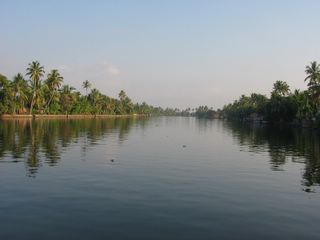
View of the main waterway to Vembanad Lake

View of the by-canals...
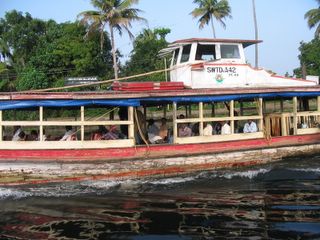
A government busboat that plys between various places
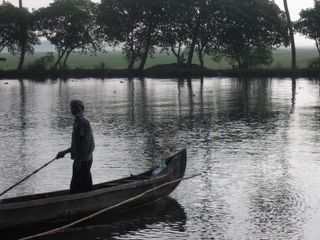
Fisherman along the canal
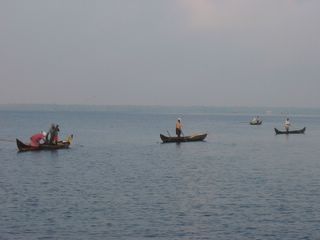
Fisherman in Vembanad Lake whose nets supposedly stalled our boat's motor
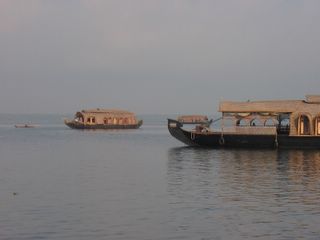
Houseboats anchored for the night...

green fields and blue sky

green fields, blue sky and white birds...
By the time we reached Kottayam it was mid afternoon with the sun blazing. While I was helping to unload the luggage RJ went to boatowner with the intention of giving him a piece of his mind. Instead he could only meet the assistant who promised that he will make the owner call and apologise. We were in Kottayam for two days but that did not happen. We hired seven autos to deliver us to the hotel - a simple but clean hotel bang on the main road in Kottayam. We'd check out this town in the next blog.
After being cooped up in a resort across the backwater for couple of days, the group was to go to Kottayam, by a boat along the canals, with breakfast on the way. We were to leave at 7 in the morning, the boatman was instructed to take us along the various canals until 9 and then get us somewhere for breakfast after which he was to drop us in Kottayam. It was all simple and straight with little cause for any confustion or misinterpretation.
For the group to be ready by 7, they had to pack the previous night and wake up early. Last thing the group on a holiday would like to do is to wake up early. So not wanting to make a mess out of this, I made number of calls to the boat owner in Kottayam to drive in the idea that the boat has to, has to, be on time. When the morning came over it was not the case. The boat kind of sluggishly made its way to the pier at 8. Meanwhile, I made few more calls to the owner and he was becoming increasingly reluctant to take my calls. Kept saying "he will come in 5 mins saar". Naturally, when the boat finally arrived, we were mad at the boatman. He countered us by saying "breakfast" and quickly realised what he said and changed it to "fishing nets in motor".
After taking us around some canals, it was time for breakfast. We left some good restaurants on the way since the chap said we could have it in R-block. This is a stretch of land that is below the canal level, which must have been reclaimed. The first one he took us to was serving ' kappa ' and fish masala . Kappa is a mashed tapioca with lots of turmeric in it and did not at all looked appealing. Later on I came to know that these two are favourites at the local toddy shops. The next one had Kappa and mussels. The next had only fish masala. It was way past breakfast time and one of the members was diabetic. RJ and I were getting angry and concerned. We made few more angry calls to the owner, who then directed the boatman to take us somewhere. How long was it to take to get there? 15 mins. We should have been wiser and told the group 30 mins. It took 45 mins and was about 5 min from where we started! Thankfully the place served lovely omlette and chapati for the group. I had veg curry and chapati. I guess, the group wasnt sure when they would have lunch so they had another round of omlettes and then topped it with extra strong coffee. Now they were a happy bunch of people again. Not that they were miffed earlier but they were certainly unhappy a bit. I guess next time I will suggest that they should carry lot of dry food for occasions like these.
The canals got completely covered with water hyacinth as we got closer to Kottayam. The boat had to stop often and the motor reversed to unshackle the roots to go entwined in it. The group was quite happy with the sights and sounds they experienced along the canals: women washing clothes and utensils, kids swimming and screaming 'give me pen', kids in dresses going to their schools screming 'give me pen'...men and women canoeing past... houses, temples, churches, small kirana stores with little packets of goodies hanging from the awning that doubles up as the shop-window shutter.

View of the main waterway to Vembanad Lake

View of the by-canals...

A government busboat that plys between various places

Fisherman along the canal

Fisherman in Vembanad Lake whose nets supposedly stalled our boat's motor

Houseboats anchored for the night...

green fields and blue sky

green fields, blue sky and white birds...
By the time we reached Kottayam it was mid afternoon with the sun blazing. While I was helping to unload the luggage RJ went to boatowner with the intention of giving him a piece of his mind. Instead he could only meet the assistant who promised that he will make the owner call and apologise. We were in Kottayam for two days but that did not happen. We hired seven autos to deliver us to the hotel - a simple but clean hotel bang on the main road in Kottayam. We'd check out this town in the next blog.
Tuesday, March 28, 2006
Alleppey
As I am off to Vizag after a long time, this blog will mostly contain pictures. Also, nothing much happened at this place other than the fact that the group had their first fill of fish. The only trouble was that the portions were too tiny. Each person could only get a small piece. Unlike other resorts, this one touts itself as an ayurvedic one, and hence stipulates food orders atleast 4 hours in advance. So RJ had to apologise and promised that the next meal will have more fish!
The place that we stayed was bang opposite the backwaters. Those of you who watch Nehru Cup, the snake race starts exactly at this point.

View from resort
I had lots of pending work to do so excused myself from most of the city outings. Actually, I was not too eager to join them after RJ told me that there is nothing much to do. This was surprising considering that Laurie Baker, the famous architect had written an entire booklet comparing Alleppey to Venice. I wished I had it then. Since I was not in the city and since I slept early, I woke up early to watch the sun come up.
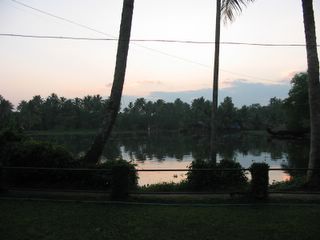
Dawn

The first rays of the sun
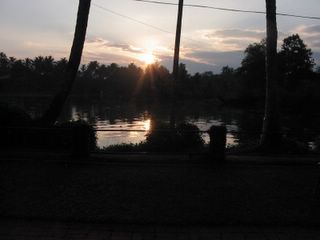
The sunrise
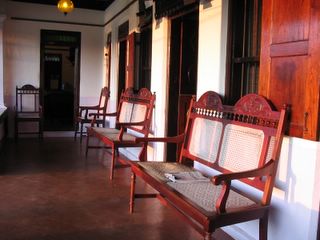
The sun-kissed verandah
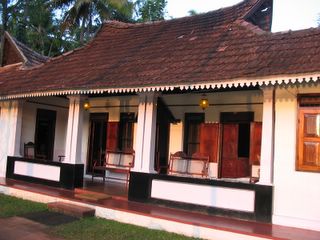
Sun-kissed Tharavad

Sun @ small aperture

The lawns in front of the backwaters
Some time in the afternoon I went for a walk around the resort and then met RJ for lunch at India Coffee House.
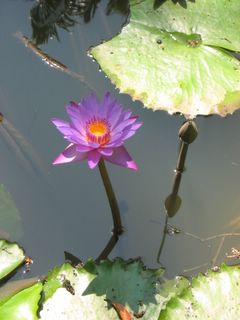
At the pond
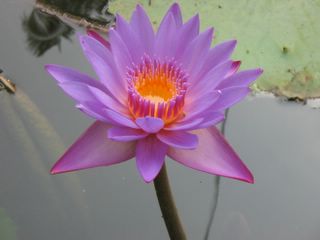
Close-up
Other than the fact that this is now a cooperative venture owned by the people working in it, there is nothing spectular. As I walked back to the resort, some of the group members were sitting out in the lawns watching the water world go by.
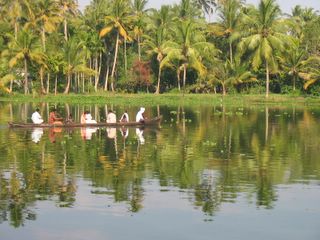
Public transport
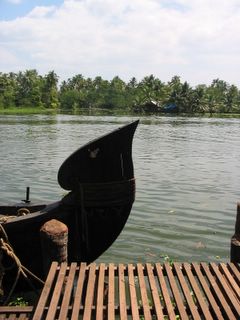
House-boat @ the jetty
While it is nice and quieter during the day, it is unbelievable during the early and late parts of the day. The backwaters is filled with house-boats going into the Vebanad lake and back. The continous sound of the motors can take the fun out of a holiday. For some of the group members who had their rooms close to the water, it did.

The way to relax (its not me)

Relax (Take 2)
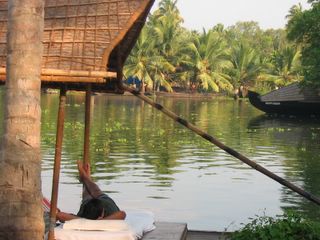
This is life!!
Actually before the tour started, I was sure Alleppey would be the best and the group will talk a lot about it. But it was not so, while it was the most expensive place we stayed in, it was certainly not the best. There were niggling details that made the stay a tad uncomfortable, atleast for RJ and me as we had to drop names just so that the staf behaves properly. Really, it is not the place that makes a great holiday, it is the people who run it who can make an ocean of difference.
The place that we stayed was bang opposite the backwaters. Those of you who watch Nehru Cup, the snake race starts exactly at this point.

View from resort
I had lots of pending work to do so excused myself from most of the city outings. Actually, I was not too eager to join them after RJ told me that there is nothing much to do. This was surprising considering that Laurie Baker, the famous architect had written an entire booklet comparing Alleppey to Venice. I wished I had it then. Since I was not in the city and since I slept early, I woke up early to watch the sun come up.

Dawn

The first rays of the sun

The sunrise

The sun-kissed verandah

Sun-kissed Tharavad

Sun @ small aperture

The lawns in front of the backwaters
Some time in the afternoon I went for a walk around the resort and then met RJ for lunch at India Coffee House.

At the pond

Close-up
Other than the fact that this is now a cooperative venture owned by the people working in it, there is nothing spectular. As I walked back to the resort, some of the group members were sitting out in the lawns watching the water world go by.

Public transport

House-boat @ the jetty
While it is nice and quieter during the day, it is unbelievable during the early and late parts of the day. The backwaters is filled with house-boats going into the Vebanad lake and back. The continous sound of the motors can take the fun out of a holiday. For some of the group members who had their rooms close to the water, it did.

The way to relax (its not me)

Relax (Take 2)

This is life!!
Actually before the tour started, I was sure Alleppey would be the best and the group will talk a lot about it. But it was not so, while it was the most expensive place we stayed in, it was certainly not the best. There were niggling details that made the stay a tad uncomfortable, atleast for RJ and me as we had to drop names just so that the staf behaves properly. Really, it is not the place that makes a great holiday, it is the people who run it who can make an ocean of difference.
Friday, March 24, 2006
The Welcome Dinner
Organising the first meal was turning out to be a difficult thing. The shacks opposite the sea served all kinds of exotic meals from the world plus dishes from north like paneer-butter masala and its likes. We tried to find out a place that serves vegetarian Kerala meals but then apparently they are none. We persisted; “there is one”, said an auto driver but it is tiny and may not be the best place to eat. When we followed the directions given by him, we came to a thatched place with side walls, also in thatch, that ran half way up. This enabled the customers as well as the rest the world to view each other as they went about doing their jobs. The tables were made from normal wood with white plastic chairs to go with them. The wash area was under a coconut tree, the water had to be drawn from a bucket with a steel tumbler. While the basic fare that was served here was veg meals, one could in addition order omelette or a plate of fish to go with it. We declined both but surprised the ‘management’ by eating enormous amounts of tomato chutney (with sliced onions in it. At home we make tomato chutney with blended onions). The food was not bad at all but we felt it was not good enough for a welcome dinner. Moreover, RJ wanted the group to have beer along with the meal.
When we finally told the hotel manager S about our difficulty in finding a place that serves Kerala meal, he said that it could be arrange at the hotel itself as the staff get their meals free in the afternoon and it is usually local food. We wanted a dinner that too of a ‘sadhya-type’. Sadhya, is the feast that is served on Onam day, which either has four or eight curries. With knowledge acquired from “The Essential Kerala Cookbook’ and an Onam meal eaten at Coconut Lagoon in Chennai, I started to narrate the dishes we would like to have (Istoo, Olan, Pachadi, Kichidi, Avial, Erisseri, Kootukari and Kalan and one sweet dish: Ada Pradhamam). S wanted to serve lunch… “Sadhya is always lunch”, he went on. We tried to reason with him, told him lets not call it Sadhaya but let us have Sadhya dishes for the dinner. He reluctantly agreed. The RJ then said, “Could we have fish?” I have to take a detour and explain why the RJ said this. Well it was all due to a cousin of mine that the Veg Tour did not start out to be a veg tour. My cousin said, “You mean you will be in Kottayam and not eat their beef curry. I can still taste the curry I had last year. You cannot have the group not eat it” His wife (a Syrian Christian) said “forget beef, you cannot miss Karimeen, yaar”… This added to the past where RJ was hinting now and then about how strict we should be with the food, should we prohibit them from eating meat at all? Or should we say that we will not pay for the meat and that if they want to, they could pay on their own. As a result of all this, I finally agreed that we could perhaps let the group have some meat/fish in Kerala and then wean them away from it. So there went the “Veg” part of the tour.
Getting back to the dinner, “Fish?” said S. We don’t serve fish for Sadhya. “Come on RJ, we can’t have fish the first day itself, said I. So the fish issue was not settled as a bigger problem came up on the horizon. “You cannot have beer on 1st of ever month in Kerala. It is a dry day”. “What?” said both of us. “You mean no where?” RJ asked… “Not even if we pay more for it?” asked I. S went on to say that they can serve beer but prefer not to. Well I was happy that it will be RJ who will break this news to the group.
The group slowly started to gather under the thatched extension of the main building, that served as the resorts restaurant. The group contained three couples (including father, mother, daughter and her boyfriend), two sisters, and two single ladies (one aged 78 and other aged 68). With an exception of the daughter and her boyfriend who were in their late 20s/early 30s, the rest were above 55. Of these three were coming to India for the first time and the other have made multiple trips. Four of them were part of RJ’s pervious trips. I tried hard to get their names but they refuse to stick in my head. Well it was just the first day.
At the dinner table, I was next to V and H. They lived in Bennekom in central Netherlands, they said. “I lived there for six month”, I said. They had a look that seems to say, “Why would you possibly be there?” I was at Hans place. Now H was surprised. She worked in a dept at the univ and they tried hard to put some of their students/visiting faculty at this place but they could never get a place. Hans and Rinske ran a pension house not very far from the Wageningen Univ, one of the well know agricultural univs in the world. They took extreme good care of their tenants. The clothes are washed and ironed; the beds made and new towels given every day. Weekends, Rinske baked cakes for everyone. It was bit more expensive than the hostels but many dept. liked to send their visiting faculty here. I told V and H of the good time I had there. They invited me to their house, next time I visit Bennekom.
V said that they travel often to Iran and he is learning Persian and hence can get a word of two if he travels in North India. I showed him our currency notes and asked him to read Urdu since it uses Arabic script. He couldn’t see it, so he took pictures of the currency notes on his 8 mega pixel digital camera and used the zoom facilities to read the letter. He was not bad.
The food came, the new group members who were in India for the first time gasped when banana leaves were placed in front of them. The entire group was fascinated the way the food was served, first istoo, then olan and then pachadi… RJ and I insisted that we be served the traditional red rice and not the white one. The food was a great success. The biggest hits were ada pradhamam (payasam made from rice strips and jaggery) and pineapple pachadi.
When the bill came, I looked into it. I normally don’t but this time I did. To my surprise, there was ‘Fish curry, 2 Nos.’ It was my turn to gasp. “Which…which of the curries was the fish?” I asked. My shock surprised me as well. Normally, I don’t get agitated if someone says “stop that has meat in it” but this time, I was. The waiter took the bill back to check with the kitchen. He comes back and says, the fish was not served as we finished the meal too quickly. It is still in the kitchen. The group was in splits, “we ate too quickly” was a joke for few days after that. I wanted to talk to the manager not wanting to pay for it but then RJ said it is only 100 Rs. and he can pay for that. Thus ended the first meal. The group had to be ready at 7 AM the next day for a walk through the beach to a place that served Kerala breakfast.
Link to Kerala Recipes
When we finally told the hotel manager S about our difficulty in finding a place that serves Kerala meal, he said that it could be arrange at the hotel itself as the staff get their meals free in the afternoon and it is usually local food. We wanted a dinner that too of a ‘sadhya-type’. Sadhya, is the feast that is served on Onam day, which either has four or eight curries. With knowledge acquired from “The Essential Kerala Cookbook’ and an Onam meal eaten at Coconut Lagoon in Chennai, I started to narrate the dishes we would like to have (Istoo, Olan, Pachadi, Kichidi, Avial, Erisseri, Kootukari and Kalan and one sweet dish: Ada Pradhamam). S wanted to serve lunch… “Sadhya is always lunch”, he went on. We tried to reason with him, told him lets not call it Sadhaya but let us have Sadhya dishes for the dinner. He reluctantly agreed. The RJ then said, “Could we have fish?” I have to take a detour and explain why the RJ said this. Well it was all due to a cousin of mine that the Veg Tour did not start out to be a veg tour. My cousin said, “You mean you will be in Kottayam and not eat their beef curry. I can still taste the curry I had last year. You cannot have the group not eat it” His wife (a Syrian Christian) said “forget beef, you cannot miss Karimeen, yaar”… This added to the past where RJ was hinting now and then about how strict we should be with the food, should we prohibit them from eating meat at all? Or should we say that we will not pay for the meat and that if they want to, they could pay on their own. As a result of all this, I finally agreed that we could perhaps let the group have some meat/fish in Kerala and then wean them away from it. So there went the “Veg” part of the tour.
Getting back to the dinner, “Fish?” said S. We don’t serve fish for Sadhya. “Come on RJ, we can’t have fish the first day itself, said I. So the fish issue was not settled as a bigger problem came up on the horizon. “You cannot have beer on 1st of ever month in Kerala. It is a dry day”. “What?” said both of us. “You mean no where?” RJ asked… “Not even if we pay more for it?” asked I. S went on to say that they can serve beer but prefer not to. Well I was happy that it will be RJ who will break this news to the group.
The group slowly started to gather under the thatched extension of the main building, that served as the resorts restaurant. The group contained three couples (including father, mother, daughter and her boyfriend), two sisters, and two single ladies (one aged 78 and other aged 68). With an exception of the daughter and her boyfriend who were in their late 20s/early 30s, the rest were above 55. Of these three were coming to India for the first time and the other have made multiple trips. Four of them were part of RJ’s pervious trips. I tried hard to get their names but they refuse to stick in my head. Well it was just the first day.
At the dinner table, I was next to V and H. They lived in Bennekom in central Netherlands, they said. “I lived there for six month”, I said. They had a look that seems to say, “Why would you possibly be there?” I was at Hans place. Now H was surprised. She worked in a dept at the univ and they tried hard to put some of their students/visiting faculty at this place but they could never get a place. Hans and Rinske ran a pension house not very far from the Wageningen Univ, one of the well know agricultural univs in the world. They took extreme good care of their tenants. The clothes are washed and ironed; the beds made and new towels given every day. Weekends, Rinske baked cakes for everyone. It was bit more expensive than the hostels but many dept. liked to send their visiting faculty here. I told V and H of the good time I had there. They invited me to their house, next time I visit Bennekom.
V said that they travel often to Iran and he is learning Persian and hence can get a word of two if he travels in North India. I showed him our currency notes and asked him to read Urdu since it uses Arabic script. He couldn’t see it, so he took pictures of the currency notes on his 8 mega pixel digital camera and used the zoom facilities to read the letter. He was not bad.
The food came, the new group members who were in India for the first time gasped when banana leaves were placed in front of them. The entire group was fascinated the way the food was served, first istoo, then olan and then pachadi… RJ and I insisted that we be served the traditional red rice and not the white one. The food was a great success. The biggest hits were ada pradhamam (payasam made from rice strips and jaggery) and pineapple pachadi.
When the bill came, I looked into it. I normally don’t but this time I did. To my surprise, there was ‘Fish curry, 2 Nos.’ It was my turn to gasp. “Which…which of the curries was the fish?” I asked. My shock surprised me as well. Normally, I don’t get agitated if someone says “stop that has meat in it” but this time, I was. The waiter took the bill back to check with the kitchen. He comes back and says, the fish was not served as we finished the meal too quickly. It is still in the kitchen. The group was in splits, “we ate too quickly” was a joke for few days after that. I wanted to talk to the manager not wanting to pay for it but then RJ said it is only 100 Rs. and he can pay for that. Thus ended the first meal. The group had to be ready at 7 AM the next day for a walk through the beach to a place that served Kerala breakfast.
Link to Kerala Recipes
Wednesday, March 08, 2006
First stop: Varkala
As a place, Varkala does not offer tourists any more than what many other places in India can offer. However, it is to Varkala that the tourists throng and not to other. To understand why, could be an entire research project in itself, like why certain regions attract industries and not others.

View of the morning sea with lone tourist performing yoga
In addition to being touristy, Varkala is also popular religious place for many locals and perhaps for many Keralites as well. Two centres that attract pilgrims are Janardhana Swamy temple and Sivagiri Mutt. Janardhana Swamy temple is on the way to the Papanasam beach, a pleasant sandy beach sandwiched between two cliffs. If one turns right just before the temple, the road winds past the Taj hotel to the north cliff. The road to the left leads to the South Cliff. Although there are some places to stay on the south cliff, it is the north cliff that attracts all attention.
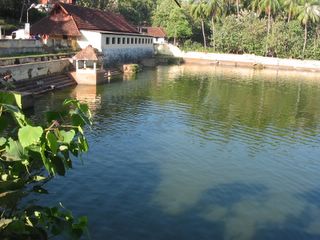
Tank2
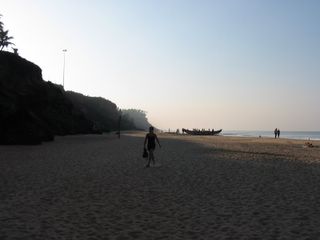
North cliff from the beach
A long winding path along the edge of the north cliff has all the ingredients that make a tourist haven: knick-knack shops selling ware from lands as far as Rajasthan, Kashmir and Tibet; restaurants with displays of fresh fish on ice that dole out non-fish dishes as well and an occasional shack that serves only veg food; places to stay with varying degrees of comfort.

on a fish hunt...

Cliff frontage at night
The main tourist zone is sandwiched between the path along the cliff and the road that leads to the north cliff from the Janardhana Swamy temple. While most tourist eat in the shacks on the cliffs watching the sea below, many stay in hotels, resorts and homes behind the cliff frontage.
It heart-warming to see small houses (some of the inhabitants still cooking on wood-stoves in the backyard) have managed to transform a room or two into a space that can be rented out to tourists. Tourism industry has given them an opportunity to earn some money. The little lanes that dot this cliff are all clean without any rubbish. Tourists can be seen enjoying the sunshine filtered through palm fronds while sitting on little tables with checked table cloth in many back yards (with the days wash still on the lines). Kerala seem to be encouraging such home-stays, which is good both for the tourist as well as the host. I would any day suggest tourists to stay at such places than at sterile resorts that the rich prefer or rodent infested cheap hotels that the back packers prefer.
Our task, the few days that we spend in Varkala before the group arrived, was to find out places to visit and restaurants to eat in. It was when the group was here I realise why hotel folk kow-tow to tour operators: the group follows what the leader says to the last dot! While Janardhana Swamy temple was a definite place to visit, we though Sivagiri mutt, though a very nice place, would not have interested these tourists. So we went on an auto ride to Anjengo, an old English Fort about 20 km away to see if it would be of interest.
Anjengo (or five coconut trees) was for a while the second most important trading port for the English after Bombay in the late 17th century. This fort is said to have been built in 1695. Actually before I found this information on the net, RJ told me that this was a Dutch port. Somewhere else it was also written that Portuguese were also here. So instead of trying to waste time arguing who owned it first and how it changed hands, we decided to visit it. We also found out that a place called the ‘Golden Island’ just off the road to Anjengo that may be of interest as well.
The route to the fort was extremely picturesque with the sea on the right and coconut trees everywhere. The way the swaying coconut trees framed the sea and the waves, it was almost a different picture frame ever few meter. Another interesting feature along the route was the number of mosques. This 20 km strip had over 10 mosques with few very large as well. I am not sure if the local population can fill even one of these large mosques completely. Doesn’t say much about the camaraderie these fishermen villages share with one and another.

Fishermen pusing the boat into the sea
Anjengo, perhaps due to the European influence has some missionary school and few churches. The village by itself was nothing spectacular. We realised that the main gate of the fort was locked with worker repairing the wall inside. The guard has just gone out for a cup of tea, we were told. A light-house that was close-by could have kept our occupied until the guard’s return but the visitors were welcomed only in the early evening. As we turned to walk back to the fort, we saw someone waving frantically: it was the guard.
The fort in itself was just the walls. The main structure has collapsed many years ago. The ASI is now trying to repair the walls (with nice cement plaster as well) so that this skeleton remains. The walls are so thick that one can easily walk over them and perhaps it was meant so as there were steps everywhere that lead to the top of the walls. Neither the fort in itself nor the views of the sea/village from the fort walls was interesting enough for the group to be here. So we went to see the Golden Island.
This island was not easily accessible. One would have to take some narrow paths that finally lead to the backwaters. The island was just a hop away on a dug-out canoe. The place was straight out of a picture post card from the tropics: it was filled with coconut trees that brought resplendent emerald green hue to the entire landscape. Right on the banks was a coir unit with women beating out the coir from the shells that have been soaked for 3 months.
Years ago, I worked with a group of women in a small village near Visakhapatnam to set up a small coir yarn making unit. Although they received good training thanks to a motivated trainer from the government, we could compete neither in quality nor in price against the golden yellow 2-ply coir yarn that came from Kerala. After seeing unit here making coir and another unit making yarn a little later, I have realised how could we have even thought of setting up a coir unit in Vizag of all places? While I was pacifying myself that history was full of such faux pas, RJ was taking snaps of people coming back from the Island after visiting the two temples there. There is nothing else on the island other than these two temples, which we forgot to mention to the group. They learnt the hard way (some of them wanted to have lunch there) that glorious sounding names mean nothing.
Some more pictures

View of the morning sea with lone tourist performing yoga
In addition to being touristy, Varkala is also popular religious place for many locals and perhaps for many Keralites as well. Two centres that attract pilgrims are Janardhana Swamy temple and Sivagiri Mutt. Janardhana Swamy temple is on the way to the Papanasam beach, a pleasant sandy beach sandwiched between two cliffs. If one turns right just before the temple, the road winds past the Taj hotel to the north cliff. The road to the left leads to the South Cliff. Although there are some places to stay on the south cliff, it is the north cliff that attracts all attention.

Tank2

North cliff from the beach
A long winding path along the edge of the north cliff has all the ingredients that make a tourist haven: knick-knack shops selling ware from lands as far as Rajasthan, Kashmir and Tibet; restaurants with displays of fresh fish on ice that dole out non-fish dishes as well and an occasional shack that serves only veg food; places to stay with varying degrees of comfort.

on a fish hunt...

Cliff frontage at night
The main tourist zone is sandwiched between the path along the cliff and the road that leads to the north cliff from the Janardhana Swamy temple. While most tourist eat in the shacks on the cliffs watching the sea below, many stay in hotels, resorts and homes behind the cliff frontage.
It heart-warming to see small houses (some of the inhabitants still cooking on wood-stoves in the backyard) have managed to transform a room or two into a space that can be rented out to tourists. Tourism industry has given them an opportunity to earn some money. The little lanes that dot this cliff are all clean without any rubbish. Tourists can be seen enjoying the sunshine filtered through palm fronds while sitting on little tables with checked table cloth in many back yards (with the days wash still on the lines). Kerala seem to be encouraging such home-stays, which is good both for the tourist as well as the host. I would any day suggest tourists to stay at such places than at sterile resorts that the rich prefer or rodent infested cheap hotels that the back packers prefer.
Our task, the few days that we spend in Varkala before the group arrived, was to find out places to visit and restaurants to eat in. It was when the group was here I realise why hotel folk kow-tow to tour operators: the group follows what the leader says to the last dot! While Janardhana Swamy temple was a definite place to visit, we though Sivagiri mutt, though a very nice place, would not have interested these tourists. So we went on an auto ride to Anjengo, an old English Fort about 20 km away to see if it would be of interest.
Anjengo (or five coconut trees) was for a while the second most important trading port for the English after Bombay in the late 17th century. This fort is said to have been built in 1695. Actually before I found this information on the net, RJ told me that this was a Dutch port. Somewhere else it was also written that Portuguese were also here. So instead of trying to waste time arguing who owned it first and how it changed hands, we decided to visit it. We also found out that a place called the ‘Golden Island’ just off the road to Anjengo that may be of interest as well.
The route to the fort was extremely picturesque with the sea on the right and coconut trees everywhere. The way the swaying coconut trees framed the sea and the waves, it was almost a different picture frame ever few meter. Another interesting feature along the route was the number of mosques. This 20 km strip had over 10 mosques with few very large as well. I am not sure if the local population can fill even one of these large mosques completely. Doesn’t say much about the camaraderie these fishermen villages share with one and another.

Fishermen pusing the boat into the sea
Anjengo, perhaps due to the European influence has some missionary school and few churches. The village by itself was nothing spectacular. We realised that the main gate of the fort was locked with worker repairing the wall inside. The guard has just gone out for a cup of tea, we were told. A light-house that was close-by could have kept our occupied until the guard’s return but the visitors were welcomed only in the early evening. As we turned to walk back to the fort, we saw someone waving frantically: it was the guard.
The fort in itself was just the walls. The main structure has collapsed many years ago. The ASI is now trying to repair the walls (with nice cement plaster as well) so that this skeleton remains. The walls are so thick that one can easily walk over them and perhaps it was meant so as there were steps everywhere that lead to the top of the walls. Neither the fort in itself nor the views of the sea/village from the fort walls was interesting enough for the group to be here. So we went to see the Golden Island.
This island was not easily accessible. One would have to take some narrow paths that finally lead to the backwaters. The island was just a hop away on a dug-out canoe. The place was straight out of a picture post card from the tropics: it was filled with coconut trees that brought resplendent emerald green hue to the entire landscape. Right on the banks was a coir unit with women beating out the coir from the shells that have been soaked for 3 months.
Years ago, I worked with a group of women in a small village near Visakhapatnam to set up a small coir yarn making unit. Although they received good training thanks to a motivated trainer from the government, we could compete neither in quality nor in price against the golden yellow 2-ply coir yarn that came from Kerala. After seeing unit here making coir and another unit making yarn a little later, I have realised how could we have even thought of setting up a coir unit in Vizag of all places? While I was pacifying myself that history was full of such faux pas, RJ was taking snaps of people coming back from the Island after visiting the two temples there. There is nothing else on the island other than these two temples, which we forgot to mention to the group. They learnt the hard way (some of them wanted to have lunch there) that glorious sounding names mean nothing.
Some more pictures
Friday, March 03, 2006
Food Tour: The beginning...
What started as a thought over a thali under a tamarind tree has culminated in a nice tour, which incidentally ended three days ago. The thought was that, considering the diversity of food in India, would few Europeans be interested in travelling around parts of South India sampling vegetarian food? The only way we could do that was to come up with a probable tour and spread the word around in Netherlands. The probable tour programme included some eating and some cooking of S.Indian food plus sightseeing. All these were wound around the core travel concept of Daari (a fair travel organisation of my friend): visiting some rural and non-touristy parts of the country. The tour was to start in Trivandrum and end in Chennai would wind around Kerala, TN and AP for 28 days.
For few months there were no takers. Just as we were about to pull the concept from the website, two showed interest and then one more and soon in a matter of few weeks we had about 13 people. I then had to make multiple field trips to finalise the schedule and most importantly hotels. While we had to book at least 6 months in advance by paying the entire amount in Kerala, hotels in TN and AP on the other hand were zapped when we wanted to book so early. One in AP even said call after Sankranti.
After few hitches, which included a cancelled booking in Kerala, we were all set to usher in the group in Trivandrum and take them directly to Varkala.

Varkala
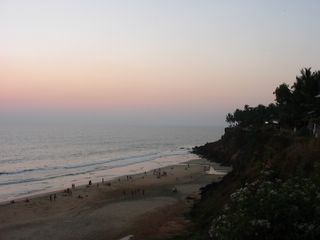
Dusk over the cliff
Then disaster struck in form of my friend being ‘hit’ by a huge wave, while he was riding them. I cannot forget the image of him coming back from the sea with a bloodied face saying “I cannot feel anything”. I froze thinking, this cannot be real and my mind was going on an overdrive conjuring extremely bleak pictures of near future that only my mind is capable of. I said something like “Can you lift your hand over your head?” or some such silly thing. He slowly started to feel tingling sensation in his hand that in the next few days turned into such a nightmarish pain for him. The doctor confirmed a minor ‘whiplash’ and was prescribed some muscle relaxants and rest for few days. A short 5 min swim before breakfast has resulted in he having a horrid time for close to a week. This meant that I had to pick up the group at 3 AM and to aid me in this endeavour was a stupid placard saying “DAARI” (since I do not know anyone in the group). I guess being at an airport with a placard is the most ego-neutralising activities I did in a long, long time. Anyway, it was the easiest task to do once I managed to make myself put the placard up.
It is strange how defensive one can get about one’s own country. Although in my case it was more in thought than in speak. While bringing the group from the airport I was bit annoyed that the driver took a short cut to Varkala from the Airport instead of taking the new smooth highway. This road was through the industrial area and as is wont with any industrial estates in this country, it was filled with pot holes. I was more annoyed when the group members were ‘understandingly’ looking at each other each time we hit a pothole; and as they raised their eybrows to each other while inspecting the gaudy steel and velvet interiors of the mini bus.
I guess this experience was good because it made me think on how I was to present my country. Instead of taking a defensive approach, I decided to talk/show about as many sides of the country as possible and let the group think whatever they want to but then such things depend on the group members. Had some of the members been from an uppity lot, then I would have had a very difficult tour. Thankfully it was’nt! Anyway, after little over an hours ride we reached the hotel, where bruised RJ welcomed the group. After a short while, the group was told to meet in the evening for a welcome Onam-type Sadhya.
For few months there were no takers. Just as we were about to pull the concept from the website, two showed interest and then one more and soon in a matter of few weeks we had about 13 people. I then had to make multiple field trips to finalise the schedule and most importantly hotels. While we had to book at least 6 months in advance by paying the entire amount in Kerala, hotels in TN and AP on the other hand were zapped when we wanted to book so early. One in AP even said call after Sankranti.
After few hitches, which included a cancelled booking in Kerala, we were all set to usher in the group in Trivandrum and take them directly to Varkala.

Varkala

Dusk over the cliff
Then disaster struck in form of my friend being ‘hit’ by a huge wave, while he was riding them. I cannot forget the image of him coming back from the sea with a bloodied face saying “I cannot feel anything”. I froze thinking, this cannot be real and my mind was going on an overdrive conjuring extremely bleak pictures of near future that only my mind is capable of. I said something like “Can you lift your hand over your head?” or some such silly thing. He slowly started to feel tingling sensation in his hand that in the next few days turned into such a nightmarish pain for him. The doctor confirmed a minor ‘whiplash’ and was prescribed some muscle relaxants and rest for few days. A short 5 min swim before breakfast has resulted in he having a horrid time for close to a week. This meant that I had to pick up the group at 3 AM and to aid me in this endeavour was a stupid placard saying “DAARI” (since I do not know anyone in the group). I guess being at an airport with a placard is the most ego-neutralising activities I did in a long, long time. Anyway, it was the easiest task to do once I managed to make myself put the placard up.
It is strange how defensive one can get about one’s own country. Although in my case it was more in thought than in speak. While bringing the group from the airport I was bit annoyed that the driver took a short cut to Varkala from the Airport instead of taking the new smooth highway. This road was through the industrial area and as is wont with any industrial estates in this country, it was filled with pot holes. I was more annoyed when the group members were ‘understandingly’ looking at each other each time we hit a pothole; and as they raised their eybrows to each other while inspecting the gaudy steel and velvet interiors of the mini bus.
I guess this experience was good because it made me think on how I was to present my country. Instead of taking a defensive approach, I decided to talk/show about as many sides of the country as possible and let the group think whatever they want to but then such things depend on the group members. Had some of the members been from an uppity lot, then I would have had a very difficult tour. Thankfully it was’nt! Anyway, after little over an hours ride we reached the hotel, where bruised RJ welcomed the group. After a short while, the group was told to meet in the evening for a welcome Onam-type Sadhya.
Subscribe to:
Posts (Atom)
